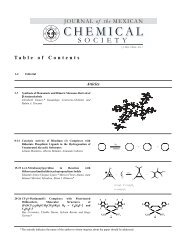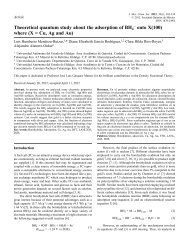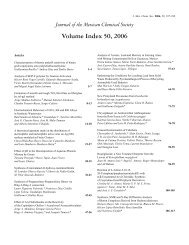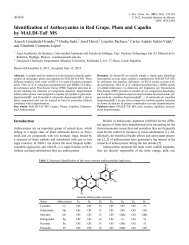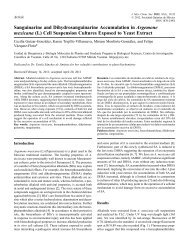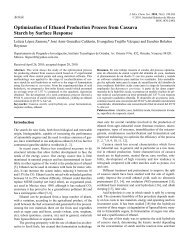SMQ-V047 N-002_ligas_size.pdf - Journal of the Mexican Chemical ...
SMQ-V047 N-002_ligas_size.pdf - Journal of the Mexican Chemical ...
SMQ-V047 N-002_ligas_size.pdf - Journal of the Mexican Chemical ...
You also want an ePaper? Increase the reach of your titles
YUMPU automatically turns print PDFs into web optimized ePapers that Google loves.
Revista de la Sociedad Química de México, Vol. 47, Núm. 2 (2003) 124-126<br />
Investigación<br />
Reactivity <strong>of</strong> IrH 2 {C 6 H 3 -2,6-(CH 2 PBu t 2) 2 } towards alkene compounds<br />
Valente Gómez-Benítez, Rocío Redón, and David Morales-Morales*<br />
Instituto de Química, Universidad Nacional Autónoma de México, Cd. Universitaria, Circuito Exterior,<br />
Coyoacán, 04510 México D. F. *E-mail: damor@servidor.unam.mx (D. Morales-Morales)<br />
Dedicated to Dr. Alfonso Romo de Vivar<br />
Recibido el 22 de noviembre del 2<strong>002</strong>; aceptado el 20 de marzo del 2003<br />
Abstract. The reactions <strong>of</strong> IrH 2 {C 6 H 3 -2,6-(CH 2 PBu t 2) 2 } with ethylene<br />
and 1-octene have been carried out, products containing <strong>the</strong><br />
olefin compounds coordinated in a η 2 fashion have been obtained.<br />
Both complexes have been characterized by multinuclear NMR probing<br />
unequivocally <strong>the</strong> proposed formulations. Examination <strong>of</strong> <strong>the</strong><br />
<strong>the</strong>rmal stability <strong>of</strong> both complexes under catalytic conditions shows<br />
<strong>the</strong> 1-octene adduct to be more stable.<br />
Keywords: PCP pincer ligands, iridium complexes, olefin complexes,<br />
dehydrogenation, catalysis.<br />
Resumen. Se llevaron a cabo reacciones del complejo IrH 2 {C 6 H 3 -<br />
2,6-(CH 2 PBu t 2) 2 } con etileno y 1-octeno, obteniéndose los derivados<br />
olefínicos coordinados de forma η 2 . Ambos complejos fueron caracterizados<br />
por RMN multinuclear, probando las formulaciones propuestas.<br />
El examen de la estabilidad térmica de ambos complejos<br />
bajo condiciones catalíticas mostró que el aducto 1-octano es más<br />
estable.<br />
Palabras clave: ligandos tipo pinza PCP, complejos de iridio, complejos<br />
olefínicos, deshidrogenación, catálisis.<br />
Introduction<br />
Terminal alkenes (alpha-olefins) are a major feedstock for <strong>the</strong><br />
production <strong>of</strong> plastics, detergents, and lubricants. Their production<br />
through <strong>the</strong> selective dehydrogenation <strong>of</strong> linear alkanes<br />
would be an attractive alternative to <strong>the</strong> present commercial<br />
processes based on hydrogen, ethylene, and trialkylaluminum<br />
catalysts.[1] The iridium PCP pincer complexes:<br />
IrH 2 {C 6 H 3 -2,6-(CH 2 PR 2 ) 2 } (R = Bu t , 1; Pr i , 2) are extraordinarily<br />
active and robust catalysts for aliphatic dehydrogenation<br />
reactions.[2-5] Recent studies <strong>of</strong> this reactivity lead to <strong>the</strong><br />
discovery <strong>of</strong> <strong>the</strong> first efficient catalytic system for <strong>the</strong> selective<br />
dehydrogenation <strong>of</strong> n-alkanes to alpha-olefins [6]. While<br />
this system serves to validate <strong>the</strong> concept <strong>of</strong> producing alphaolefins<br />
through this method, it suffers from several practical<br />
limitations. The concentrations <strong>of</strong> <strong>the</strong> dehydrogenated products<br />
were found to quickly attain a low (1.5-4.0 %), constant<br />
value. Fur<strong>the</strong>rmore, <strong>the</strong> high selectivity for alpha-olefins was<br />
found to be short lived as <strong>the</strong> complexes show secondary catalytic<br />
activity for alkene isomerization and <strong>the</strong> alkene distribution<br />
rapidly shifted towards <strong>the</strong> internal isomers.[6] Finally,<br />
<strong>the</strong> requisite consumption <strong>of</strong> a stoichiometric amount <strong>of</strong> a sacrificial<br />
hydrogen acceptor used in <strong>the</strong> reported selective dehydrogenation<br />
<strong>of</strong> n-alkanes is economically and environmentally<br />
unattractive. Liu and Goldman had previously achieved <strong>the</strong><br />
<strong>the</strong>rmochemical dehydrogenation <strong>of</strong> linear alkanes by 2 without<br />
<strong>the</strong> use <strong>of</strong> a hydrogen acceptor. However, only internal<br />
alkenes were produced in <strong>the</strong>ir experiments [4].<br />
As a part <strong>of</strong> our continuous interest in <strong>the</strong> reaction mechanism<br />
ruling in this process we have tried to identify <strong>the</strong> probable<br />
olefin intermediate species during <strong>the</strong> reaction, although<br />
some <strong>of</strong> <strong>the</strong>se complexes are extremely reactive and shortlived,<br />
reactions with simple alkenes might shed light in both<br />
<strong>the</strong> initial stages <strong>of</strong> <strong>the</strong> olefin isomerization process and <strong>the</strong><br />
deactivation <strong>of</strong> <strong>the</strong> catalyst by product inhibition reactions<br />
which have not yet been explored. Thus, in this paper we wish<br />
to present <strong>the</strong> results obtained from <strong>the</strong> reactions <strong>of</strong> IrH 2<br />
{C 6 H 3 -2,6-(CH 2 PBu t 2) 2 } with ethylene and 1-octene.<br />
Experimental<br />
Materials and methods<br />
Unless stated o<strong>the</strong>rwise, all reactions were carried out under<br />
an atmosphere <strong>of</strong> argon using conventional Schlenk glassware<br />
and Young NMR tubes. Solvents were degassed and dried<br />
using standard procedures. The 1 H NMR spectra were recorded<br />
on a Varian Unity Inova 400 spectrometer. <strong>Chemical</strong> shifts<br />
are reported in ppm down field <strong>of</strong> TMS using <strong>the</strong> solvent as<br />
internal standard (cyclohexane-d 12 , δ 1.38). 13 C and 31 P NMR<br />
spectra were recorded with complete proton decoupling and<br />
are reported in ppm downfield <strong>of</strong> TMS with solvent as internal<br />
standard (cyclohexane-d 12 , δ 26.45) and external 85 % H 3 PO 4<br />
respectively. Elemental analyses were determined on a Perkin-<br />
Elmer 240. Positive-ion FAB mass spectra were recorded on a<br />
JEOL JMS-SX102A mass spectrometer operated at an accelerating<br />
voltage <strong>of</strong> 10 Kv. Samples were desorbed from a<br />
nitrobenzyl alcohol (NOBA) matrix using 3 KeV xenon<br />
atoms. Mass measurements in FAB are performed at a resolution<br />
<strong>of</strong> 3000 using magnetic field scans and <strong>the</strong> matrix ions as<br />
<strong>the</strong> reference material or, alternatively, by electric field scans<br />
with <strong>the</strong> sample peak bracketed by two (polyethylene glycol<br />
or cesium iodide) reference ions. The 1-octene was purchased






